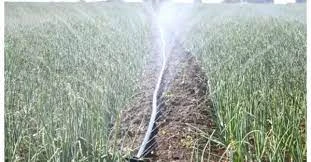What is a rain hose irrigation system?
In the agricultural heartland of Kenya, where the success of crops relies heavily on efficient irrigation, finding the right tools for the job is crucial. One such innovation that is gaining popularity among farmers is the Rain Hose Pipe. If you’re looking to enhance your irrigation system and boost your crop yields, this article is for you.
Table of Contents
What is a rain hose irrigation system?
Imagine your Kenyan farm bathed in a perpetual mist, where crops thrive under the delicate caress of raindrops, and water dances a waltz of efficiency. This isn’t a daydream – it’s the reality brought to life by Rain Hose irrigation, a revolutionary system transforming Kenyan agriculture.

But what exactly is this watery wizardry? Rain Hose is a lightweight, flexible pipe with strategically placed perforations. Think of it as a personal cloud hovering just above your crops, showering them with gentle, targeted water droplets. Instead of harsh sprays or wasteful runoffs, Rain Hose mimics the natural rhythms of rainfall, delivering hydration directly to plant roots with precision and care.
Buy by Clicking on Rain Hose Pipe for sale in Kenya
Rain Hose Pipe Prices in Kenya
Finding the right Rain Hose irrigation kit for your Kenyan farm can revolutionize your watering and boost your harvest. But navigating different diameters and prices can be tricky. No worries, this table gives you a clear overview of Rain Hose pipe options and their costs:
| Diameter (mm/inch) | Flow Rate per 100m (m³/hr) | Price in KES |
| 32mm (1″) | 13 | 2,600 |
| 40mm (1-1/4″) | 16 | 4,500 |
| 50mm (1-1/2″) | 22 | 5,500 |
5 Benefits of Rain Hose Pipe
Cost-Effective Solution
Traditional irrigation systems can be expensive to install and maintain. Rain Hose Pipes offer a cost-effective alternative, reducing the overall investment required for a reliable irrigation setup.
Water Efficiency
With the Rain Hose Pipe, water is distributed evenly over the entire length of the hose, minimizing wastage. This not only conserves water but also ensures that each plant receives the necessary moisture for optimal growth.
Time-Saving
Setting up a Rain Hose Pipe is a quick and straightforward process. Farmers can save valuable time compared to traditional irrigation methods, allowing them to focus on other essential tasks on the farm.
Versatility
Whether you have a small garden or a vast agricultural field, Rain Hose Pipes are available in different lengths to suit your specific needs. They can be easily moved and repositioned as needed, providing versatility in irrigation planning.
Low Maintenance
Traditional irrigation systems often require regular maintenance to prevent clogging and ensure proper functioning. Rain Hose Pipes have minimal maintenance requirements, making them a hassle-free choice for busy farmers.
Rain Hose vs. Drip Irrigation
Kenyan farmers, the rhythm of rain dictates your dance, but what if you could become the rainmaker yourself? Two innovative irrigation systems, Rain Hose and Drip Irrigation, promise lush harvest victories. But which warrior deserves your watering crown? Let’s dive into a head-to-head comparison to guide your green revolution:
Rain Hose vs. Drip Irrigation in Kenya
| Feature | Rain Hose | Drip Irrigation |
| Water Delivery | Gentle overhead mist through perforated pipes | Precise drips to plant roots through emitters |
| Water Efficiency | High (Up to 70% savings) | Highest (Up to 90% savings) |
| Yield Boost | Moderate (Up to 30% increase) | High (Up to 50% increase) |
| Labor Effort | Low maintenance, minimal manual watering | Moderate maintenance, regular emitter cleaning |
| Versatility | Suitable for various crops and farm sizes | Ideal for row crops, greenhouses, and water-scarce regions |
| Cost | Lower initial investment, affordable options | Higher initial investment, specialized emitters |
| Installation | Easy DIY setup, minimal connections | Requires technical expertise, precise emitter placement |
| Wind Vulnerability | Water droplets can be affected by strong winds | Emitters protected within tubing, wind-resistant |
How to assemble a rain hose irrigation system kit
Here’s a step-by-step guide on how to assemble a Rain Hose irrigation system kit, using simple language and highlighting the required components:
Components Required
- Rain Hose pipes: Lightweight, flexible pipes with perforations for water delivery.
- Starter off-takes: Connect the Rain Hose to the main water pipe.
- Pipe connectors: Join Rain Hose sections together.
- Mini valves: Control water flow to different areas.
- End caps: Seal the ends of the Rain Hose.
- Main water line: The primary pipe supplying water to the system (often PVC or HDPE).
- Water pump or tank: Provides water pressure for the system.
- Tools: Wrench, pliers, shovel (for trenching if needed), tape measure.
Steps for Installing rain hose irrigation system kit in Kenya
Plan your layout
- Measure your field or garden area and determine the ideal placement of Rain Hose pipes.
- Consider crop spacing and water requirements.
- Sketch a layout to visualize the setup.
Prepare the main line
- If burying the main line, trench a shallow path for it.
- Connect the main water source (pump or tank) to the main line using appropriate fittings.
- Ensure the main line is level and free of leaks.
Install starter off-takes
- Locate where you want to start the Rain Hose lines.
- Drill a hole in the main line using a hole saw.
- Insert the starter off-take and secure it tightly with a wrench.
Attach Rain Hose pipes
- Connect one end of a Rain Hose pipe to the starter off-take using a pipe connector.
- Unroll the Rain Hose along the planned path.
- Use additional pipe connectors to join multiple Rain Hose sections if needed.
- Secure connections with pliers.
Install end caps
- At the end of each Rain Hose line, attach an end cap to prevent water leakage.
Add mini valves (optional)
- If you want to control water flow to specific areas, install mini valves along the Rain Hose lines.
Test the system
- Turn on the water supply and check for leaks.
- Observe water distribution and adjust Rain Hose placement or valve settings as needed.
Where to Find Rain Hose Pipes in Kenya
If you’re eager to upgrade your irrigation system with Rain Hose Pipes, look no further than Advert.co.ke. Our platform connects buyers and sellers, making it easy for you to find high-quality agricultural tools and equipment.
At Advert.co.ke, you can explore a variety of Rain Hose Pipes for sale in Kenya, each listed by reputable sellers. The platform provides a user-friendly interface, allowing you to browse through different options, compare prices, and make informed decisions.
FAQ
What is a Rain Hose?
It’s a lightweight, flexible pipe with perforated holes that delivers water directly to plant roots, mimicking natural rainfall.
Why choose Rain Hose over other irrigation methods?
Rain Hoses save water (up to 70%), boost yields, reduce labor, and offer versatility for different farm sizes and crops.
Can I use Rain Hose for any crop?
Absolutely! From veggies and fruits to flowers and shrubs, Rain Hose caters to diverse needs.
Is Rain Hose easy to install?
Yes! It’s a DIY-friendly system with minimal maintenance needs. We also offer installation guidance.
How long do Rain Hoses last?
With proper care, Rain Hoses can last for several years. We provide durable options and replacement parts.
Is Rain Hose affordable?
Rain Hoses offer a long-term return on investment by saving water and boosting yields. We also have budget-friendly options.

